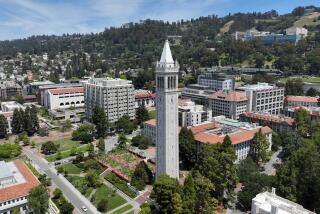At Last, a UC Admissions Plan That Rewards Merit
- Share via
Sometimes the simplest solutions are the most revolutionary. As legislators and University of California administrators work to preserve access to the university system in the Proposition 209 era, a new approach to achieving ethnic balance is gaining support. A number of policy-makers have recently proposed that UC admission should be guaranteed to the top-ranking graduates of each of California’s 844 high schools. Because the high schools’ student populations are diverse--some rich, some poor, some overwhelmingly Anglo, some overwhelmingly African American, Latino or Asian American--their top graduates will reflect that diversity. If this principle is adopted, not only will both sides of the affirmative-action debate have to face up to the fallacies of their positions, but also everyone with a stake in public education will have to evaluate where California’s schools and universities are heading and what they should stand for.
Of the many proposals embodying this principle, the one with the best chance of implementation would offer automatic UC admission to the top 4% of each high school’s graduates.
Neither this plan nor the others can accurately be called “affirmative action,” as that term has come to be understood. Nevertheless, affirmative-action critics, while seeing some merit in the proposals, are skeptical. UC Regent Ward Connerly, for example, has warned that “if we stack the deck so we get so many students from South-Central Los Angeles and so many from Compton High, there is a question whether it is giving preferential treatment.” Such treatment, Connerly contends, would violate Proposition 209.
Connerly and similarly minded critics of affirmative action have always insisted that “merit” should be the overriding, if not the sole, criteria for determining access to jobs and higher education. And their idea of merit has always been inseparably related to a particular vision of “fairness.” Which is why it will be instructive to watch their reaction to a principle that, on its face, seeks to reward merit and promote fairness.
After all, reserving UC slots for the top 4% of the students at each of the state’s high schools is purely merit-driven. These students compete with classmates who generally share socioeconomic backgrounds and enjoy similar access to educational resources. If they excel, their reward will be admission to one of UC’s nine campuses. If they fall short, they can’t insist they didn’t get a fair chance.
The principle would undoubtedly slightly favor students at schools such as Compton High, where only 1% of graduating students currently attend UC, over students at wealthier, higher-achieving schools such as Beverly Hills High, where more an 20% of each class registers at UC campuses. But isn’t fairness asking each student to do the best he or she can under the circumstances, and rewarding those who succeed? Notably, even the 4%-admissions plan would only fill one-third of the slots in the UC’s freshman class, (primarily with Anglos and Asian Americans), leaving two-thirds open to competition among all graduating seniors.
Some will claim that the best students at some of the state’s weaker high schools do not have what it takes to become productive UC students. But that presumption was recently challenged by the man ultimately responsible for turning out productive UC graduates, UC President Richard C. Atkinson. “If you are saying that, in a large high school, the top four people in every hundred aren’t UC eligible, I think they are.”
The simple notions of merit and fairness embedded in these new proposals will almost certainly cause problems for some affirmative-action supporters, who will be forced to make a hard trade-off between political correctness and practical outcomes.
One of the practical effects of affirmative action in college admissions has been to lower the admissions bar for African American and Latino students. At any given multiethnic high school in California, an Anglo senior might need, at a minimum, a 3.7 grade-point average to get into the college of his choice. On the other hand, previous admission data at the same college might show that his African American and Latino classmates could expect to be admitted with, for example, a GPA of only 3.2. Few educators, parents or even students themselves would deny that if you set lower expectations for children, the likely result will be lower achievement.
From a strict historical perspective, it may not be “fair” to ignore centuries of relative disadvantage and demand that African American and Latino students compete straight-up with their Anglo classmates. From a practical perspective, however, implementing a uniform standard at schools where all students share similar economic backgrounds might spur African American and Latino academic achievement. Those who would insist otherwise will have to argue that black and brown students are inherently less intelligent and hard-working than their white and yellow counterparts.
Finally, the 4%-admission plan should spark a much-needed debate on the nature of public education, both at the high school and university levels. The focus will likely be both on UC’s mission and on how access to the benefits of a UC education should be allocated. Should it be offered equally to all the state’s 18-year-olds, or disproportionately to the already favored few?
Implementing the plan would also put on display the academic talents of the top 4% of each of California’s high schools, along with the strengths and weaknesses of the high schools that produced them. Many already suspect that the results will reveal that we do not truly have a public education “system” but instead a multitiered education apparatus, in which unequal funding and preparation produce some of the world’s best students but also some with virtually no useful skills. The ultimate impact of the 4%-admission plan, then, will be to squarely put a difficult set of education issues before the Legislature and UC administrators with a clarity never seen before.
More to Read
Sign up for Essential California
The most important California stories and recommendations in your inbox every morning.
You may occasionally receive promotional content from the Los Angeles Times.










